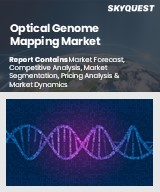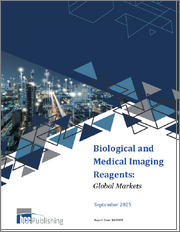
|
시장보고서
상품코드
1572383
생물학적 이미징 시약 시장, 기회, 성장 촉진요인, 산업 동향 분석과 예측(2024-2032년)Biological Imaging Reagents Market, Opportunity, Growth Drivers, Industry Trend Analysis and Forecast, 2024-2032 |
||||||
세계의 생물학적 이미징 시약 시장은 만성질환의 만연의 증가와 연구개발에 대한 고액 투자에 의해 2024-2032년 CAGR 7.3%를 나타냅니다.
생물학적 이미징 시약 산업의 성장을 가속하는 요인으로는 전 세계에서 높아진 건강 인식, 이미징 기술의 기술 발전, 영상 진단 절차 증가 등을 들 수 있습니다. 전 세계 의료 시스템이 질병의 조기 발견과 맞춤형 의료에 중점을 두면서 고급 이미징 시약에 대한 수요가 급증하고 있습니다. 또한 이미징 기술에서 AI와 머신러닝의 통합은 진단 정확도를 향상시켜 생물학적 이미징 시약 시장의 성장을 더욱 촉진하고 있습니다.
또한 멀티모달 이미징 기술의 확대는 생물학적 이미징 시약에 대한 수요를 증가시켜 생물 의학 연구, 임상 진단, 치료법 개발 등의 분야를 변화시키고 있으며, MRI, PET, CT, 형광 현미경 등의 모달리티를 결합하여 멀티모달 이미징은 생물학적 과정과 질병을 보다 명확하고 정확하게 포착할 수 있습니다. 은 생물학적 과정과 질병을 보다 명확하고 정확하게 포착할 수 있습니다. 이러한 종합적인 방법은 질병을 더 잘 파악하고 이해할 수 있도록 도와주며, 이를 위해 다양한 영상 시약의 필요성이 증가하고 있습니다.
생물학적 이미징 시약 시장은 제품 유형별로 조영제, 광학 시약, 핵 시약으로 구분되며, 2023년 조영제가 44.8%로 가장 큰 점유율을 차지할 것으로 예상됩니다. 질병의 조기 발견과 맞춤형 의료에 대한 관심이 높아지면서 특정 영상 진단 시약에 대한 수요가 증가하고 있습니다. 전 세계에서 의료 시스템이 진단의 정확성을 우선시하는 가운데, 영상의 선명도와 정확도를 높여주는 약품에 대한 수요가 가장 많이 증가하고 있습니다. 이러한 추세는 현대 의학에서 첨단 영상 진단 기술에 대한 의존도가 높아지고 있음을 입증합니다.
생물학적 이미징 시약 시장의 용도에는 임상 진단, 신약 개발, 연구 및 기타 분야가 포함되며, 임상 진단은 2032년까지 97억 달러에 달할 것으로 예상됩니다. 전 세계에서 건강 인식이 높아지고 질병의 조기 발견이 촉진되면서 이미징 시약에 대한 수요가 증가하고 있습니다. 전 세계에서 의료 시스템이 진단의 정확성을 우선시하는 가운데, 영상의 선명도와 정확성을 향상시키는 약품에 대한 수요가 가장 많이 증가하고 있습니다. 이러한 추세는 현대 의학에서 첨단 영상 진단 기술에 대한 의존도가 높아지고 있음을 지원합니다.
북미 생물학적 이미징 시약 산업은 2023년 47억 달러 규모로 연평균 6.9% 성장할 것으로 예상됩니다. 북미 생물학적 이미징 시약 산업은 최첨단 이미징 기술과 시설을 갖춘 탄탄한 의료 인프라에 의해 지원되고 있습니다. 이러한 첨단 인프라는 첨단 이미징 시약에 대한 수요를 촉진할 뿐만 아니라 이 지역을 생의학 연구 및 혁신의 선두주자로 자리매김하고 있습니다. 또한 이 지역의 연구개발에 대한 헌신은 공공 및 민간 투자에 의해 지원되어 첨단 이미징 기술과 시약의 개발 및 채택을 가속화하고 있습니다.
목차
제1장 조사 방법과 조사 범위
제2장 개요
제3장 업계 인사이트
- 에코시스템 분석
- 업계에 대한 영향요인
- 촉진요인
- 만성질환의 증가
- 멀티모달 이미징의 채택 확대
- 연구개발 투자의 증가
- 업계의 잠재적 리스크 & 과제
- 엄격한 정부 규제
- 촉진요인
- 성장 가능성 분석
- 상환 시나리오
- 규제 상황
- 기술적 전망
- Porter의 산업 분석
- PESTEL 분석
- 갭 분석
- 향후 시장 동향
제4장 경쟁 구도
- 서론
- 기업 매트릭스 분석
- 기업 점유율 분석
- 경쟁 포지셔닝 매트릭스
- 전략 대시보드
제5장 시장 추산·예측 : 제품 유형별, 2021-2032년
- 주요 동향
- 조영시약
- 광학 시약
- 핵시약
제6장 시장 추산·예측 : 이미징 모달리티별, 2021-2032년
- 주요 동향
- MRI
- 초음파
- X선 및 CT
- 광학 이미징
- 핵의학 이미징
- PET
- SPECT
- 기타 핵의학 영상법
제7장 시장 추산·예측 : 용도별, 2021-2032년
- 주요 동향
- 임상 진단
- 종양학
- 순환기
- 신경학
- 기타 임상 진단 용도
- Drug Discovery와 의약품 개발
- 조사와 혁신
- 기타 용도
제8장 시장 추산·예측 : 최종 용도별, 2021-2032년
- 주요 동향
- 병원
- 영상 진단 센터
- 연구·학술기관
- 제약·바이오테크놀러지 기업
- 기타 최종사용자
제9장 시장 추산·예측 : 지역별, 2021-2032년
- 주요 동향
- 북미
- 미국
- 캐나다
- 유럽
- 독일
- 영국
- 프랑스
- 스페인
- 이탈리아
- 네덜란드
- 기타 유럽
- 아시아태평양
- 중국
- 일본
- 인도
- 호주
- 한국
- 기타 아시아태평양
- 라틴아메리카
- 브라질
- 멕시코
- 아르헨티나
- 기타 라틴아메리카
- 중동 및 아프리카
- 남아프리카공화국
- 사우디아라비아
- 아랍에미리트
- 기타 중동 및 아프리카
제10장 기업 개요
- Bayer AG
- Bracco
- Carl Zeiss
- Cell Signaling Technology
- Danaher
- General Electric Company
- Guerbet
- Jubilant Pharmova Limited
- Luminex Corporation
- Nikon Corporation
- Novartis AG
- Olympus Corporation
- Promega Corporation
- Sartorius AG
- Thermo Fisher Scientific Inc.
The Global Biological Imaging Reagents Market will show a 7.3% CAGR between 2024 and 2032, fueled by the rising prevalence of chronic diseases and significant investments in research and development. Factors driving the growth of the Biological Imaging Reagents industry include the rising global health awareness, technological advancements in imaging techniques, and the increasing number of diagnostic imaging procedures. As healthcare systems worldwide emphasize early disease detection and personalized medicine, the demand for advanced imaging reagents has surged. Furthermore, the integration of AI and machine learning in imaging technologies is enhancing diagnostic accuracy, further propelling the growth of the biological imaging reagents market.
Further, the growing use of multimodal imaging techniques is boosting the demand for biological imaging reagents, transforming fields like biomedical research, clinical diagnostics, and therapeutic development. By combining modalities like MRI, PET, CT, and fluorescence microscopy, multimodal imaging offers a clearer and more precise view of biological processes and diseases. This holistic method enhances the identification and understanding of medical conditions, fueling the need for a variety of imaging reagents compatible with multiple modalities.
The overall Biological Imaging Reagents Industry is sorted based on product type, image modality, application, end use, and region.
The biological imaging reagents market is segmented by product type into contrast reagents, optical reagents, and nuclear reagents, with contrast reagents commanding a leading share of 44.8% in 2023. The growing emphasis on early disease detection and personalized medicine is driving the demand for specific imaging agents. As healthcare systems globally prioritize precision in diagnostics, the need for agents that enhance imaging clarity and accuracy becomes paramount. This trend underscores the increasing reliance on advanced imaging techniques in modern medicine.
The biological imaging reagents market's application segments include clinical diagnostics, drug discovery, research, and others, with clinical diagnostics expected to reach USD 9.7 billion by 2032. The rising global health awareness and the push for early disease detection are pivotal in driving the demand for imaging agents. As healthcare systems globally prioritize precision in diagnostics, the need for agents that enhance imaging clarity and accuracy becomes paramount. This trend underscores the increasing reliance on advanced imaging techniques in modern medicine.
North America biological imaging reagents industry, valued at USD 4.7 billion in 2023, is set to grow at a CAGR of 6.9%. North America's biological imaging reagents industry is bolstered by its robust healthcare infrastructure, characterized by state-of-the-art imaging technologies and facilities. This advanced infrastructure not only drives the demand for sophisticated imaging reagents but also positions the region as a leader in biomedical research and innovation. Furthermore, the region's commitment to R&D, backed by substantial public and private investments, accelerates the development and adoption of cutting-edge imaging technologies and reagents.
Table of Contents
Chapter 1 Methodology and Scope
- 1.1 Market scope and definitions
- 1.2 Research design
- 1.2.1 Research approach
- 1.2.2 Data collection methods
- 1.3 Base estimates and calculations
- 1.3.1 Base year calculation
- 1.3.2 Key trends for market estimation
- 1.4 Forecast model
- 1.5 Primary research and validation
- 1.5.1 Primary sources
- 1.5.2 Data mining sources
Chapter 2 Executive Summary
- 2.1 Industry 360° synopsis
Chapter 3 Industry Insights
- 3.1 Industry ecosystem analysis
- 3.2 Industry impact forces
- 3.2.1 Growth drivers
- 3.2.1.1 Rising prevalence of chronic conditions
- 3.2.1.2 Growing adoption of multi-modal imaging
- 3.2.1.3 Increasing investments in research and development
- 3.2.2 Industry pitfalls and challenges
- 3.2.2.1 Stringent government regulations
- 3.2.1 Growth drivers
- 3.3 Growth potential analysis
- 3.4 Reimbursement scenario
- 3.5 Regulatory landscape
- 3.6 Technological landscape
- 3.7 Porter's analysis
- 3.8 PESTEL analysis
- 3.9 Gap analysis
- 3.10 Future market trends
Chapter 4 Competitive Landscape, 2023
- 4.1 Introduction
- 4.2 Company matrix analysis
- 4.3 Company market share analysis
- 4.4 Competitive positioning matrix
- 4.5 Strategy dashboard
Chapter 5 Market Estimates and Forecast, By Product Type, 2021 - 2032 ($ Mn)
- 5.1 Key trends
- 5.2 Contrast reagents
- 5.3 Optical reagents
- 5.4 Nuclear reagents
Chapter 6 Market Estimates and Forecast, By Imaging Modality, 2021 - 2032 ($ Mn)
- 6.1 Key trends
- 6.2 MRI
- 6.3 Ultrasound
- 6.4 X-ray and CT
- 6.5 Optical imaging
- 6.6 Nuclear imaging
- 6.6.1 PET
- 6.6.2 SPECT
- 6.6.3 Other nuclear imaging modalities
Chapter 7 Market Estimates and Forecast, By Application, 2021 - 2032 ($ Mn)
- 7.1 Key trends
- 7.2 Clinical diagnostics
- 7.2.1 Oncology
- 7.2.2 Cardiology
- 7.2.3 Neurology
- 7.2.4 Other clinical diagnostic application
- 7.3 Drug discovery and development
- 7.4 Research and innovation
- 7.5 Other applications
Chapter 8 Market Estimates and Forecast, By End-Use, 2021 - 2032 ($ Mn)
- 8.1 Key trends
- 8.2 Hospitals
- 8.3 Diagnostic imaging centers
- 8.4 Research and academic institutes
- 8.5 Pharmaceutical and biotechnology companies
- 8.6 Other end-users
Chapter 9 Market Estimates and Forecast, By Region, 2021 - 2032 ($ Mn)
- 9.1 Key trends
- 9.2 North America
- 9.2.1 U.S.
- 9.2.2 Canada
- 9.3 Europe
- 9.3.1 Germany
- 9.3.2 UK
- 9.3.3 France
- 9.3.4 Spain
- 9.3.5 Italy
- 9.3.6 Netherlands
- 9.3.7 Rest of Europe
- 9.4 Asia Pacific
- 9.4.1 China
- 9.4.2 Japan
- 9.4.3 India
- 9.4.4 Australia
- 9.4.5 South Korea
- 9.4.6 Rest of Asia Pacific
- 9.5 Latin America
- 9.5.1 Brazil
- 9.5.2 Mexico
- 9.5.3 Argentina
- 9.5.4 Rest of Latin America
- 9.6 Middle East and Africa
- 9.6.1 South Africa
- 9.6.2 Saudi Arabia
- 9.6.3 UAE
- 9.6.4 Rest of Middle East and Africa
Chapter 10 Company Profiles
- 10.1 Bayer AG
- 10.2 Bracco
- 10.3 Carl Zeiss
- 10.4 Cell Signaling Technology
- 10.5 Danaher
- 10.6 General Electric Company
- 10.7 Guerbet
- 10.8 Jubilant Pharmova Limited
- 10.9 Luminex Corporation
- 10.10 Nikon Corporation
- 10.11 Novartis AG
- 10.12 Olympus Corporation
- 10.13 Promega Corporation
- 10.14 Sartorius AG
- 10.15 Thermo Fisher Scientific Inc.



















